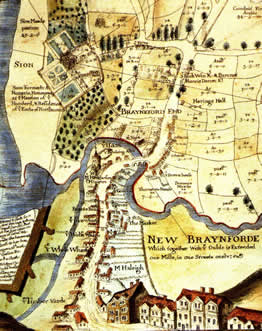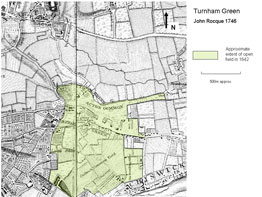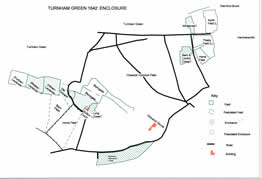Battlefield Terrain
Brentford

Moses Glover's 1635 map of Brentford (click for larger image)
At the time of the battle, Brentford consisted of one main street, lined on each side with houses and shops, which ran for roughly one mile. The town had three distinct parts; Old Brentford to the east, New Brentford to the west of that, running as far as the triple-arched stone bridge over the River Brent, and Brentford End on the western side of the river, a ribbon of houses which stretched for more than 200 yards along the road towards Hounslow Heath. On the north side of the road in New and Old Brentford enclosed gardens were located behind the properties, while on the south side the houses backed on to the confluence of the Brent and Thames, or the Thames itself. Old Brentford had some substantial houses; a number of them were three storeys high. St Lawrence’s church stood, as now, on the south side of the road, its fifteenth-century rag-stone tower, topped by a spire, dominated the skyline of New Brentford and provided a vantage point from which the low-lying land to the west of the town could be scanned.
Beyond Brentford End there were fields on either side of the London Road, shown on Moses Glover’s 1635 map of the Hundred of Isleworth. These were a mixture of arable and pasture; the enclosures bounded by hedges and ditches. To the south-west of Brentford End was Syon House, converted from a Bridgettine monastery after the reformation. North of Syon House on the London Road stood Sir Richard Wynn’s house, where the initial fighting at Brentford took place.To the north-east of the town was the open common field, but along the Great West Road toward Turnham Green were further enclosures.
Turnham Green

Rocque's 1748 map of Turnham Green and its surrounding area (click for larger image)
In the 1640s 100 acres of Turnham Green lay within the parish of Chiswick and perhaps a further 30 acres in Acton. The modern open spaces of Turnham Green, Chiswick Back Common, Acton Common and Acton Green are the remnants of Turnham Green, which then extended as far east as Stamford Brook. On the north side were hedged fields on the rising ground towards Acton’s common fields, and there were also enclosures on the west side of the green, separating it from the riverside village of Strand on the Green.
On the south side of the green was Chiswick Common Field, extending almost to the village of Chiswick and St Nicholas’s church, and the walled gardens of the Jacobean Chiswick House. In 1662 the Dutch artist William Schellinks described Chiswick as lying ‘in a great plain’. This was the open space formed by Turnham and Acton greens and Chiswick common field; the site of the battlefield. The green alone was far too small to contain the two armies. Even so, the parliamentarian front must have been tightly packed. The royalists had the opposite problem; they could not match the parliamentarians’ frontage, so much so that Essex’s horse extended beyond their left wing, which was in danger of being outflanked and revealed the extent of their numerical weakness.
The Great West Road crossed Turnham Green, lined with a straggle of houses and a windmill,adjacent to a small enclosure. From Acton Green a lane led toward the village of Acton. A separate road crossing Chiswick Common Field linked the Great West Road to the village of Chiswick, whilst another running by the enclosure to the west of the common field connected the hamlet of Little Sutton and Sutton Court to the road. This latter road was probably used by the royalists to deploy their army at Turnham Green. On the eastern side of the battlefield roads two roads led from the West Road to Chiswick. These were probably used by the parliamentarian army to deploy on the battlefield on 13 November.
Rocque Map: This map was drawn by the 18th century cartographer John Rocque in the middle of the century. It shows Turnham Green and the surrounding area around one hundred years after the battle. In this intervening period, the amount of enclosure has increased and the road network has probably become more substantial. The green area shows the extent of the battlefield, brown the likely areas of enclosure in 1642 and the red, built-up areas.

A composite map showing the extent of enclosure and the field system around Turnham Green in 1642 (click for larger image)
Enclosure Map: This map is based on a Tudor account of the extent of enclosure in and around Turnham Green at the end of the 16th century. Fields identified in this account have been identified on later, 19th century maps, and a composite map produced. The Berrygate field system on the west of the batlefield, which is known to have been susceptible to becoming boggy, and Home Field on the east are likely to have determined how the royalist and parliamentarian forces deployed during the battle.

